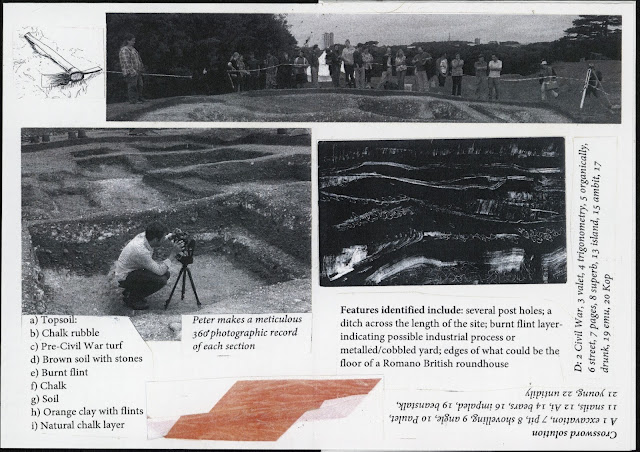The second and third week of the dig involved the team in completing the re-opening of the 1960s box-grid excavation. Archaeologists, students, researchers, local volunteers: all working to gather as much information as possible from this little area of ground, giving up its secrets as the different contexts were worked down through.
The different layers beneath the turf are called 'contexts'. At Basing House the layers included a burnt-flint layer above a crushed chalk floor of what were probably late iron-age round houses.
The production of zines consumed a great deal of my time - with some assistance on folding duties from a few of the students,and patient support from the visitor centre staff when the photocopier jammed or needed logging-in.
The zines aimed to capture some of my thoughts and reflections and to provide a memento/souvenir of the experience for the members of the dig team. I made limited editions of 52 signed copies of each zine. I suppose I did that to make them somehow more 'special' more personal, more 'valuable' to the recipients.
I was working with limited studio-access and limited media: paper, drawing pens, a b/w printer, my friend's home made pasta-press for producing mono prints, black litho/relief ink, some coloured pencils.
My output reflects those limitations but it was more limited by the size of my imagination.
Some students wanted to try mono-printing techniques so I did a number of mini workshops with two students at a time coming to my makeshift studio and producing their first ever mono-prints. Some even made work with archaeology themes. A few of their prints appeared in the zines, one commanded the front cover of zine Vol. 5.
The material excavated and dumped on the spoil heap included beautifully formed flints, crumbling soft chalk, clay, stone, earth, roots, bits of old tyre...all had their own charm.
The working methods with spade and shovel, mattock and trowel allowed layers to be cleared efficiently and sensitively down to a fine shaving of soil to find the edges of each feature and context.
Each find was thoroughly documented - from a Carling Black Label can to a stunningly preserved Roman coin.
Making work in response to all this excitement was a challenge. So many visualising technologies were in use by the team, with meticulous section drawing, formal photography and image capture to enable computer modelling - that I found myself withdrawing to the comfort zone of old technology, pen and paper, glue and scissors and printmaking.
Perhaps next time I will be braver and engage with some new media expressions.
It was a privilege to work beside these people and to see the sum total of human knowledge and happiness increased by a notch or two.
















































